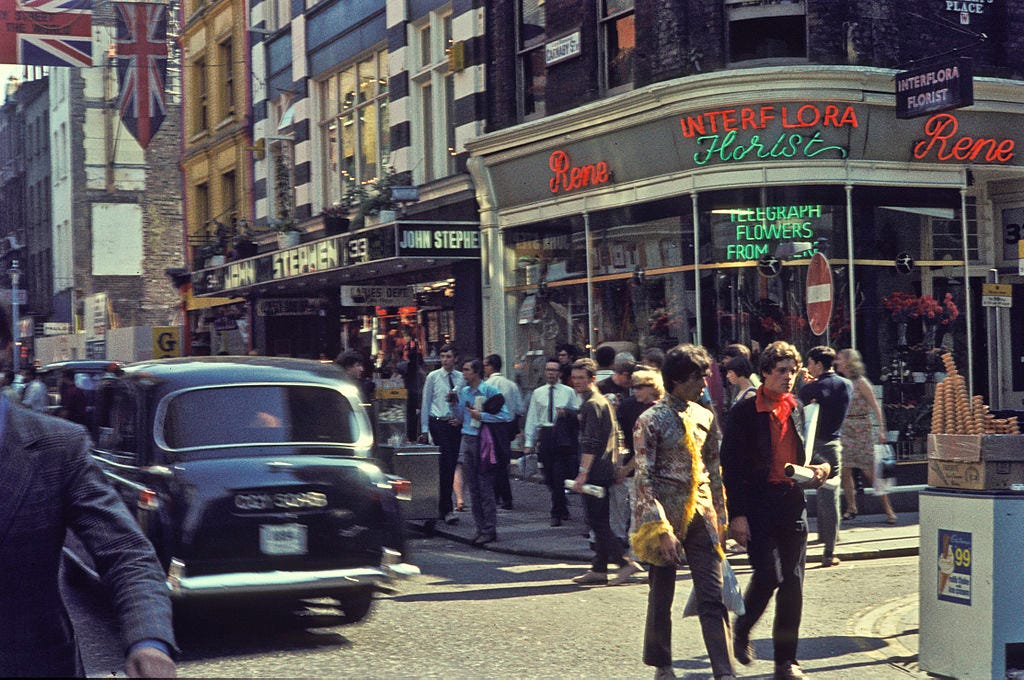Take a walk with me through this country’s capital. See the old familiar places: the parks, the markets, the towers and terraced houses, the muddy ribbon of the river. We’ll read the city, left to right, like a page. From Harrow we meander through Wembley and Willesden, curving along the canal towards Paddington.
We pause at Speakers’ Corner before making our way down to Westminster. Skirting crowds of tourists at Trafalgar Square, we pass through lively Soho streets; perhaps we stop to hear the choir at St Paul’s. We visit the ravens at the Tower. At Greenwich we start thinking about the time.
Everything is in its expected place, but you will begin to notice strange things on our tour. This is a city constructed in celluloid – London as seen through film clips and recordings from the past century or so. To mark its centenary this year, the BBC put its sprawling archive online: a map of London invites visitors to explore recordings from each borough. Street by street we peer into the past.
Elsewhere, London’s Screen Archives hold footage from the turn of the last century onwards, and the remarkable London Sound Survey preserves street noises, voices and other sounds from 1880 to the present day. For some Londoners it is an invitation down memory lane; for many it is a trip to a completely foreign country. Look, listen: they do things differently there.
Some of the events I encounter during visits to these archives are familiar to me, historic moments that made global headlines. Policemen frogmarch Sylvia Pankhurst away from a suffragette procession in Trafalgar Square in 1913. On the same spot over eight decades later, Nelson Mandela greets a jubilant crowd.
Paul and Linda McCartney marry in Old Marylebone Town Hall in 1969, while teenage girls sob on the street outside. Londoners experience thick fog in the 1940s, extreme heat in the 1960s, a freak tornado in 2006. In 1953, street parties across the city mark the Queen’s coronation.
There's the newsworthy, and then there’s the downright extraordinary. Take the exotic snake enthusiast in Leytonstone in the eighties, whose pythons and boas roam his house, their scaled bellies rubbing along his bookshelves. Or the meeting of the International Brotherhood of Clowns, all oversized bow ties and red noses, in Dalston in the seventies.
There’s the dog show in White City in 1922 which features "The smallest dog in the World", a crumb of a puppy in grainy black and white, or the fortune teller at a bank holiday fair on Hampstead Heath in 1939. I’ve paid her a few visits now, enjoying the consistent inaccuracy of her insights.
My favourite scenes are the unremarkable ones, the ones recorded by amateurs which document the everyday. I ride the tube among immaculately coiffed women in 1963, change trains, then find myself in a sea of bowler hats in 1927. I watch horse-drawn buses in 1903 bedecked with adverts for Quaker Oats and Nestle’s Milk; London’s streets are lined with dung. I see footage of weddings and parties from across the decades, populated by forgotten, grinning ghosts.
I listen to the shouts of the jellied eel merchant in the fifties (“Finest in the world!... Large lumps!”), and the haunting song of the lavender seller in the thirties. At Kew in 1915, wounded soldiers play croquet on crutches. Children have their faces painted on a grey day in Hounslow in 1989.
This is a new way of experiencing the city, a kind of historical flânerie. I dip into scenes weightlessly, reminded of Virginia Woolf's description of walking through London as “gliding smoothly on the surface” in her essay “Street Haunting”. “Let us dally a little longer,” she writes, “be content still with surfaces only — the glossy brilliance of the motor omnibuses; the carnal splendour of the butchers' shops with their yellow flanks and purple steaks; the blue and red bunches of flowers burning so bravely through the plate glass of the florists' windows.”
Some things don’t change. The buses remain (glossily, brilliantly) red. The pigeons are ubiquitous. People seem cheerful, irritable, tired. Children frown at the camera with furious interest. These are things I can probably see just by stepping out of my own front door, but I choose instead to roam this faded city online. Little details please me, things that I might not notice or care for in person.
Susan Sontag observes that photography “creates another habit of seeing: both intense and cool, solicitous and detached; charmed by the insignificant detail, addicted to incongruity.” Though I’m exploring moving images, not photographs, her description still resonates. I am charmed by the insignificant detail. Look at the tender way that couple is dancing; the man testily checking his watch at the bus stop; that piece of graffiti. “Marc was here”, it reads.
Maybe that’s why I like this view of London so much – it is a record of the many ephemeral moments that make up life in a teeming city. The graffiti I spotted no longer exists, nor is the wall it adorned, torn down to make space for the new Westway through Notting Dale. But the record remains for us to see: Marc was here. These lives, these brief moments in history, have been preserved. The clips in these archives are testaments to “time’s relentless melt” (Sontag again), but also small bastions against it. “[T]he image-world... bids to outlast us all,” she writes.
But I digress, and other scenes from around the city clamour for my attention. Long lines of people, hands stuffed wearily in pockets, wait for a train in 1923. Fanfare marks the accession of a new king at St James’s Palace in 1936. Horse-drawn carriages congest Blackfriars Bridge forty years earlier. Women in stiff Victorian dresses and top-hatted men pass along the pavement; some swing umbrellas, others carry folded newspapers. People drink, people dance, people demonstrate. Drizzle forever envelops the streets.
/////
Pictures: H. Grobe / Leonard Bentley


